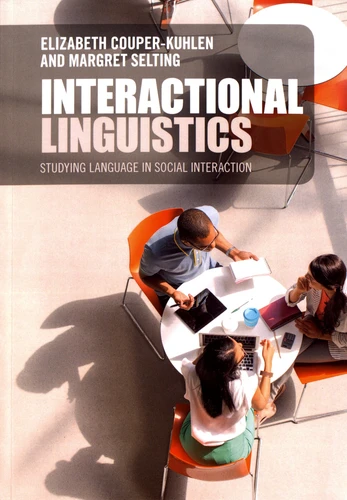Interactional Linguistics. Studying Language in Social Interaction
Par : ,Formats :
- Paiement en ligne :
- Livraison à domicile ou en point Mondial Relay entre le 24 juillet et le 30 juilletCet article sera commandé chez un fournisseur et sera expédié 6 à 12 jours après la date de votre commande.
- Retrait Click and Collect en magasin gratuit
- Livraison à domicile ou en point Mondial Relay entre le 24 juillet et le 30 juillet
- Réservation en ligne avec paiement en magasin :
- Indisponible pour réserver et payer en magasin
- Nombre de pages617
- PrésentationBroché
- FormatGrand Format
- Poids1.203 kg
- Dimensions17,4 cm × 24,7 cm × 4,8 cm
- ISBN978-1-107-61603-5
- EAN9781107616035
- Date de parution30/09/2017
- ÉditeurCambridge University Press
Résumé
The first textbook dedicated to interactional linguistics, focusing on linguistic analyses of conversational phenomena, this introduction provides an overview of the theory and methodology of interactional linguistics. Reviewing recent findings on linguistic practices used in turn construction and turn taking, repair, action formation and ascription, sequence and topic organization, the book examines the way linguistic units of varying size - sentences, clauses, phrases, clause combinations, particles - are mobilized for the implementation of specific actions in talk-in-interaction.
A final chapter discusses the implications of an interactional perspective for our understanding of language, as well as its variation, diversity, and universality. It is an essential resource for advanced undergraduate, and postgraduate, courses on language in social interaction, sociolinguistics, discourse analysis, and linguistic anthropology. Features : summary boxes provide synopses of the most important points in sections, allowing students to focus on the central issues in each chapter ; transcripts from recordings of everyday conversation enable students to apply abstract concepts to familiar real-life situations ; supplementary online chapters explore additional topics, such as the linguistic organization of preference, stance, footing, and storytelling, as well as the use of prosody and phonetics, and further practices with language.
A final chapter discusses the implications of an interactional perspective for our understanding of language, as well as its variation, diversity, and universality. It is an essential resource for advanced undergraduate, and postgraduate, courses on language in social interaction, sociolinguistics, discourse analysis, and linguistic anthropology. Features : summary boxes provide synopses of the most important points in sections, allowing students to focus on the central issues in each chapter ; transcripts from recordings of everyday conversation enable students to apply abstract concepts to familiar real-life situations ; supplementary online chapters explore additional topics, such as the linguistic organization of preference, stance, footing, and storytelling, as well as the use of prosody and phonetics, and further practices with language.
The first textbook dedicated to interactional linguistics, focusing on linguistic analyses of conversational phenomena, this introduction provides an overview of the theory and methodology of interactional linguistics. Reviewing recent findings on linguistic practices used in turn construction and turn taking, repair, action formation and ascription, sequence and topic organization, the book examines the way linguistic units of varying size - sentences, clauses, phrases, clause combinations, particles - are mobilized for the implementation of specific actions in talk-in-interaction.
A final chapter discusses the implications of an interactional perspective for our understanding of language, as well as its variation, diversity, and universality. It is an essential resource for advanced undergraduate, and postgraduate, courses on language in social interaction, sociolinguistics, discourse analysis, and linguistic anthropology. Features : summary boxes provide synopses of the most important points in sections, allowing students to focus on the central issues in each chapter ; transcripts from recordings of everyday conversation enable students to apply abstract concepts to familiar real-life situations ; supplementary online chapters explore additional topics, such as the linguistic organization of preference, stance, footing, and storytelling, as well as the use of prosody and phonetics, and further practices with language.
A final chapter discusses the implications of an interactional perspective for our understanding of language, as well as its variation, diversity, and universality. It is an essential resource for advanced undergraduate, and postgraduate, courses on language in social interaction, sociolinguistics, discourse analysis, and linguistic anthropology. Features : summary boxes provide synopses of the most important points in sections, allowing students to focus on the central issues in each chapter ; transcripts from recordings of everyday conversation enable students to apply abstract concepts to familiar real-life situations ; supplementary online chapters explore additional topics, such as the linguistic organization of preference, stance, footing, and storytelling, as well as the use of prosody and phonetics, and further practices with language.



